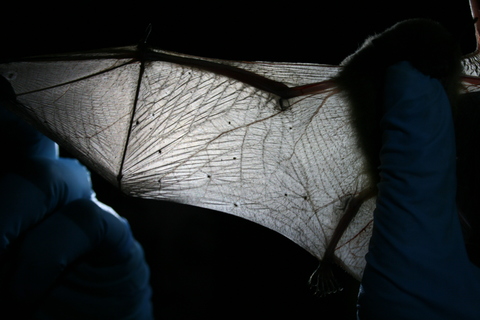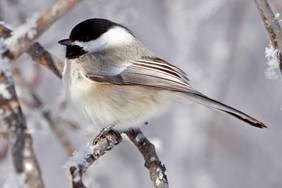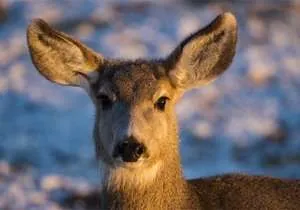![]()
New Tool Will Help Conserve Western Songbirds
The sweet singing and tranquil trills of native songbirds provide a musical backdrop across the western United States’ sagebrush country. These unique songs provide more than aesthetic beauty and do more than make us smile – they serve as barometers for health of the range.
A new online tool aims to aid land managers in better targeting management actions to benefit songbirds: a songbird abundance layer added to the Sage Grouse Initiative Interactive Map. Developed by the U.S. Fish and Wildlife Service, Sage Grouse Initiative, and Western Association of Fish and Wildlife Agencies, the updated map shows predicted abundance for nine species of sagebrush- and woodland-obligate songbirds. The map includes citizen science data from the annual North American Breeding Bird Survey.
The tool can help managers target conifer removal projects away from areas important for declining pinyon jays, while still offering benefits to imperiled sagebrush-dependent birds, such as the greater sage-grouse, which serves as an “umbrella species” because it depends upon healthy sagebrush habitat that also provides food, water, shelter, and space for other wildlife, such as the sage sparrow, sage thrasher, Brewer’s sparrow, and green-tailed towhee.
Explore the new map feature at: http://map.sagegrouseinitiative.com/
New Research Illuminates Deadly Bat Disease

UV Light Could Treat Bats’ Fungal Malady
Scientists recently identified what may be an exciting new tool for fighting the fungus behind deadly white-nose syndrome (WNS): UV-light! WNS is a disease that has killed about 6 million North American bats since it was first discovered in upstate New York in 2006. There are over 40 bat species in the United States, and nearly half of them are hibernators, potentially putting them at risk for WNS, which has spread as far west as Nebraska and also leaped to Washington state.
The fungus associated with WNS – fittingly and ominously known as P. destructans – is a cold-loving organism that rouses bats during their winter hibernation, causing bats to deplete their fat and energy reserves and eventually die of starvation. As of October 2017, WNS been confirmed in 31 states and 5 Canadian provinces.
The new research provides a glimmer of hope: exposure to UV light can seemingly kill the WNS-causing fungus 85-99% of the time (a survival rate as low as 1-15%). Scientists must next test the method on infected bats and further study how a potential treatment might be applied in the field.
Bat are important pollinators and insect-eaters throughout the United States, providing billions of dollars in ecological services by, for instance, reducing the need for pesticides in agriculture. Explore how citizens and scientists are monitoring for WNS out west and discover 10 tips to help bats in your local community.
Did You Know?
 |
Birds Weather Winter In Many WaysThe black-capped chickadee is a bird commonly seen across much of North America; it lives year-round throughout the western, midwestern, and northeastern United States, in addition to parts of Canada and Alaska. Have you heard or seen one lately? Listen to its distinctive “chickadee-dee-dee” song. Explore how birds stay warm in winter using many methods – including shivering, feather fluffing, roosting, cuddling, and tucking in their feet and beaks – and discover backyard birding tips and bird feeding best practices to see these spunky feathered fluff balls up close. Photo: Black-capped chickadee by John Carr/USFWS What’s Wild
Songbirds need sagebrush, too. See where they’re singing: map.sagegrouseinitiative.com
New Tool Will Help Conserve Western SongbirdsThe sweet singing and tranquil trills of native songbirds provide a musical backdrop across the western United States’ sagebrush country. These unique songs provide more than aesthetic beauty and do more than make us smile – they serve as barometers for health of the range. A new online tool aims to aid land managers in better targeting management actions to benefit songbirds: a songbird abundance layer added to the Sage Grouse Initiative Interactive Map. Developed by the U.S. Fish and Wildlife Service, Sage Grouse Initiative, and Western Association of Fish and Wildlife Agencies, the updated map shows predicted abundance for nine species of sagebrush- and woodland-obligate songbirds. The map includes citizen science data from the annual North American Breeding Bird Survey. The tool can help managers target conifer removal projects away from areas important for declining pinyon jays, while still offering benefits to imperiled sagebrush-dependent birds, such as the greater sage-grouse, which serves as an “umbrella species” because it depends upon healthy sagebrush habitat that also provides food, water, shelter, and space for other wildlife, such as the sage sparrow, sage thrasher, Brewer’s sparrow, and green-tailed towhee. Explore the new map feature at: http://map.sagegrouseinitiative.com/ New Research Illuminates Deadly Bat Disease
Scientists inspect a bat’s wing for deadly white-nose syndrome, a fungal disease that has killed millions of cave-dwelling bats across North America. Photo: Ann Froschauer/USFWS
UV Light Could Treat Bats’ Fungal MaladyScientists recently identified what may be an exciting new tool for fighting the fungus behind deadly white-nose syndrome (WNS): UV-light! WNS is a disease that has killed about 6 million North American bats since it was first discovered in upstate New York in 2006. There are over 40 bat species in the United States, and nearly half of them are hibernators, potentially putting them at risk for WNS, which has spread as far west as Nebraska and also leaped to Washington state. The fungus associated with WNS – fittingly and ominously known as P. destructans – is a cold-loving organism that rouses bats during their winter hibernation, causing bats to deplete their fat and energy reserves and eventually die of starvation. As of October 2017, WNS been confirmed in 31 states and 5 Canadian provinces. The new research provides a glimmer of hope: exposure to UV light can seemingly kill the WNS-causing fungus 85-99% of the time (a survival rate as low as 1-15%). Scientists must next test the method on infected bats and further study how a potential treatment might be applied in the field. Bat are important pollinators and insect-eaters throughout the United States, providing billions of dollars in ecological services by, for instance, reducing the need for pesticides in agriculture. Explore how citizens and scientists are monitoring for WNS out west and discover 10 tips to help bats in your local community. Did You Know?
|




